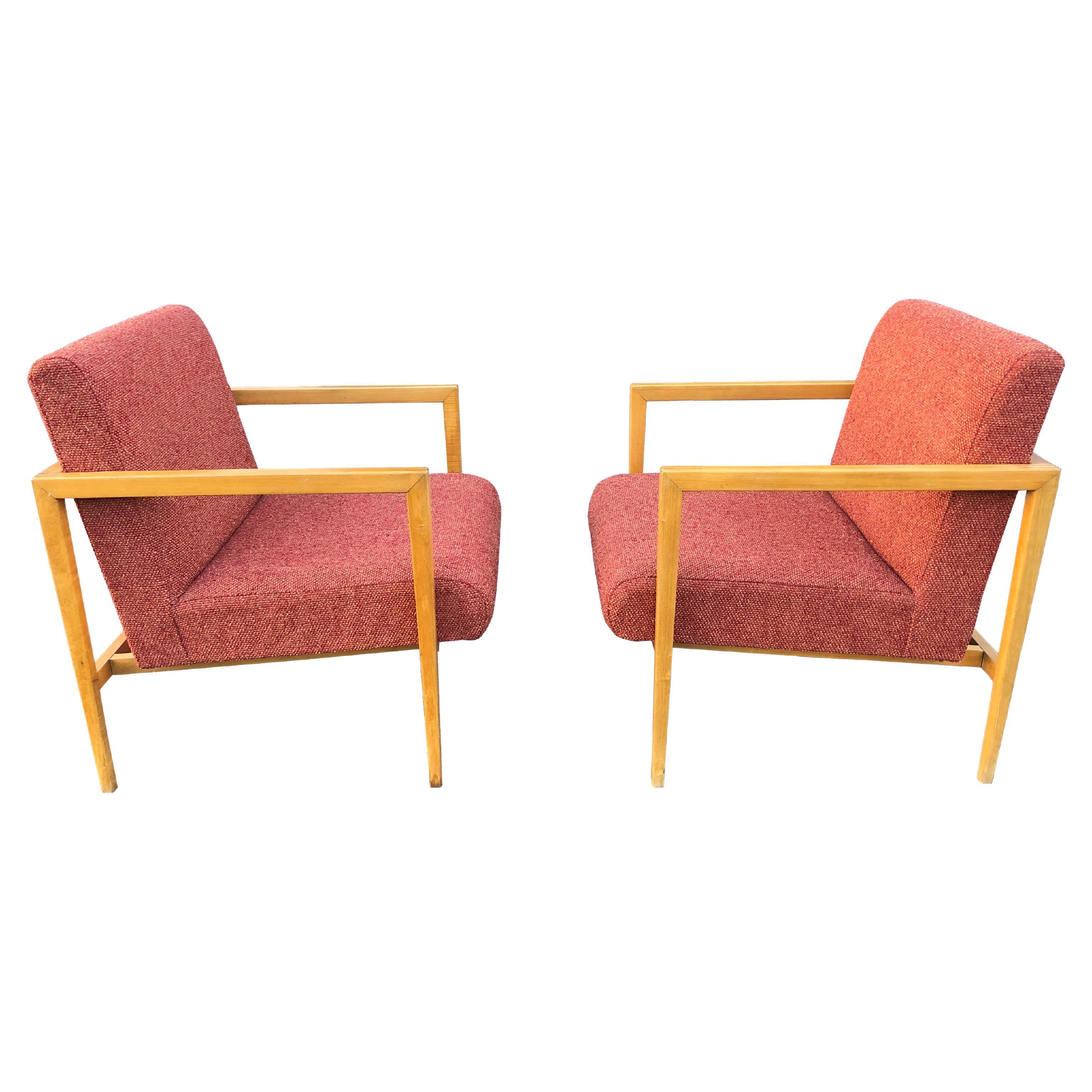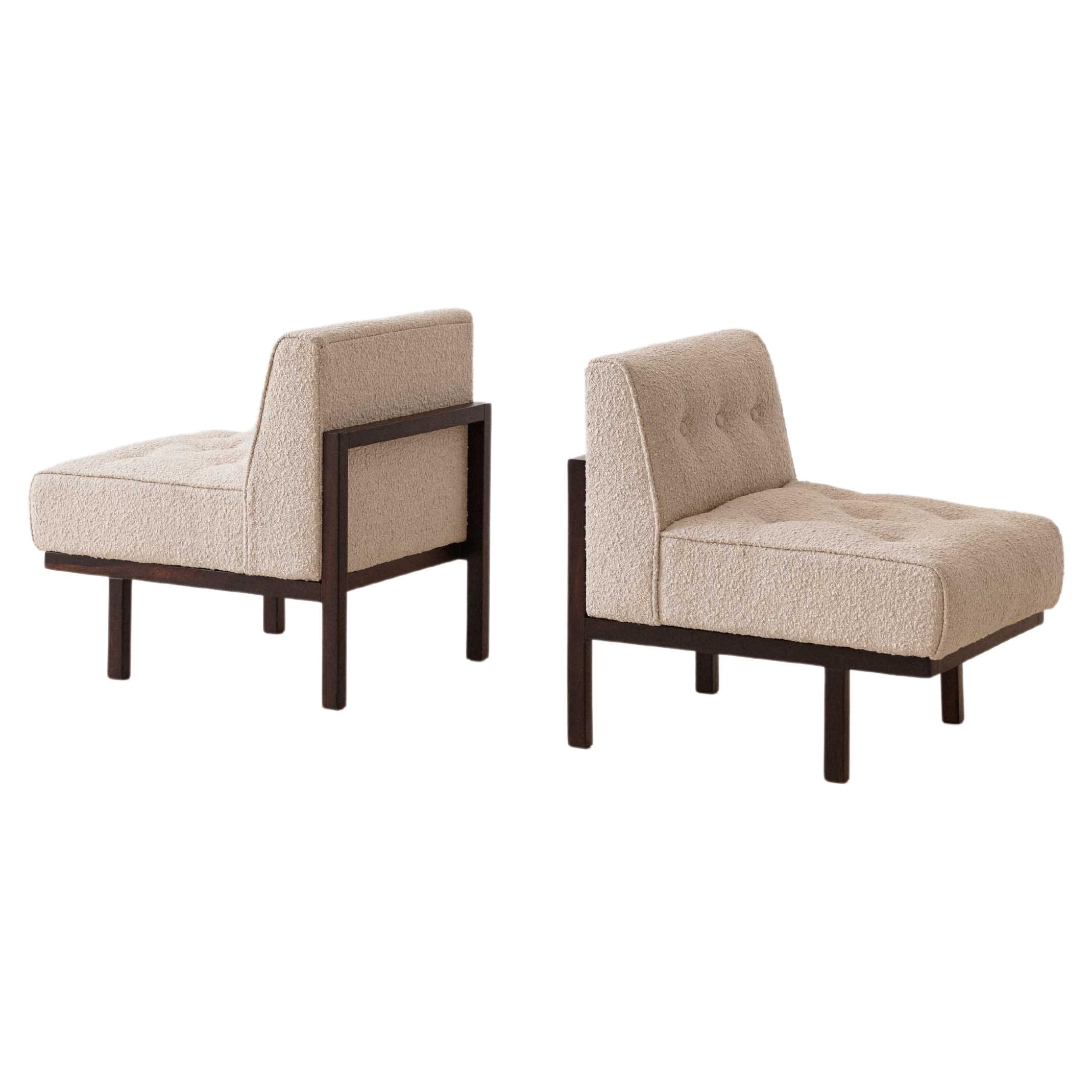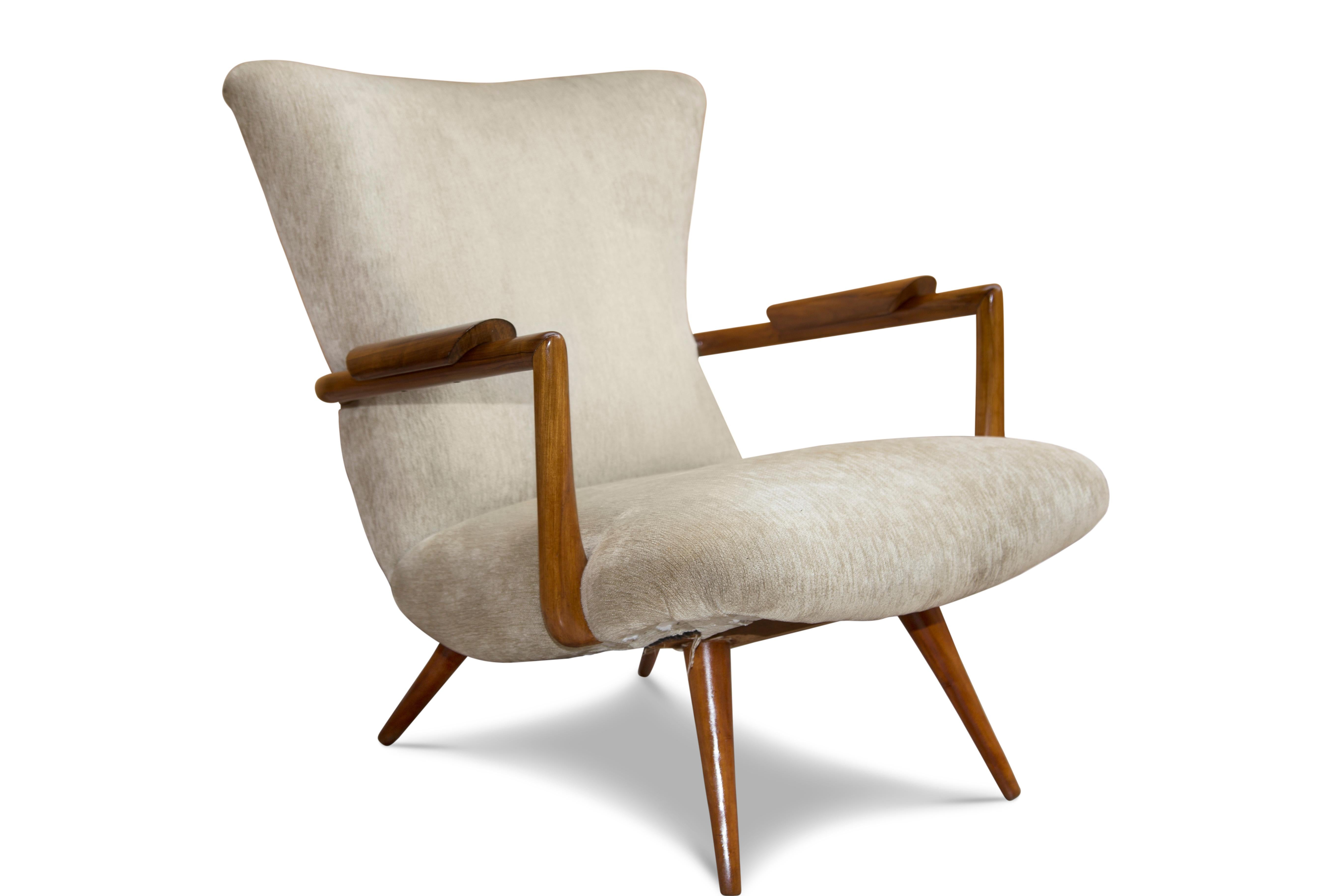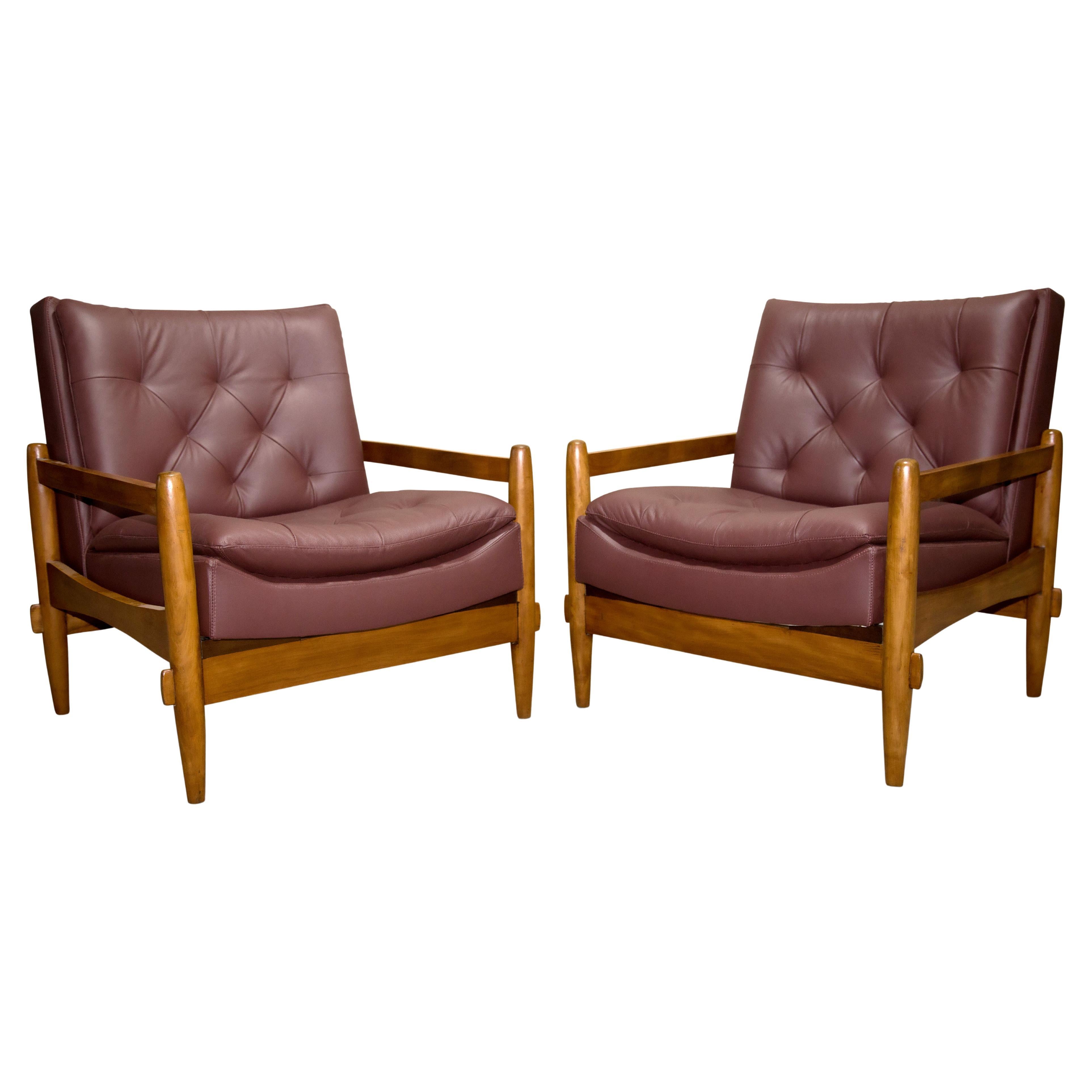Items Similar to Branco e Preto Pair of Modern Brazilian Armchairs solid jacaranda wood, fabric
Want more images or videos?
Request additional images or videos from the seller
1 of 7
Branco e Preto Pair of Modern Brazilian Armchairs solid jacaranda wood, fabric
About the Item
Branco e Preto (Miguel Forte, Jacob Ruchti, Plinio Groce, Roberta Aflalo, Carlos Millan & Che Y Hwa)
Pair of armchairs model “R3”
Sold as individual items as well
Manufactured by Mahlmeister & Cia
Brazil, 1950s
Solid jacaranda, upholstery
Measurements:
61 cm L x 58.4 cm W x 7 cm
24 in L x 23 in W x 29 H in
Literature
Branco e Preto by Marlene Milan Acayaba published by Instituto Lina Bo e Pietro Maria Bardi.
Branco e Preto was an architecture and design store, opened in late 1952, in São Paulo. Existing until 1970, it was one of the precursors of interior architecture and modern-inspired furniture in Brazil. The studio was managed by the architects Miguel Forte (1915-2002), Jacob Ruchti (1917-1974), Plínio Croce (1921-1984), Roberto Aflalo (1926-1992), Carlos Millan (1927-1964) and the Chinese architect Chen Y Hwa who had their offices in the same building at Rua Barão de Itapetininga. With the exception of the latter, who arrived in Brazil in 1952 and was employed at Croce and Aflalo’s office, the entire group graduated from Mackenzie Architecture University. The interest in modern architecture was the common denominator of all these young architects who, realizing the gap that exists in the market for modern furniture in São Paulo in the early 1950s, decided to create a store to offer an alternative of modern taste to the São Paulo elite.
Mackenzie Architecture University was very conservative in the 1930s and 1940s. Architect Christiano Stockler das Neves (1889-1982), then professor and director, maintained a critical view of modernism. With an ideal of neoclassicist aesthetics. This group of young architects who founded Branco e Preto however, nurtured their interest in modern architecture.
Graduated in the 1930s, Jacob Ruchti and Miguel Forte approached, during the course, to two architects of the first modernist generation in Brazil: the Italian Rino Levi (1901-1965) and the Ukrainian Gregori Warchavchik (1896-1972). Living together at the home of Mina Klabin, Warchavchik’s wife, allows them to meet the American architect Philip Johnson (1906-2005) and the German architect Mies Van der Rohe (1886-1969). Plínio Croce and Roberto Aflalo, who graduated in the late 1940s, and Carlos Millan, graduated in the early 1950s, also distance themselves from the architecture taught at the college, admiring the Viennese Richard Neutra (1892-1970) and Marcel Breuer (1902 -1981).
The environment of São Paulo in the 1940s and 1950s brought renovations not only in the city, which was expanding, but also in the fields of art and architecture. In 1947, the São Paulo Art Museum Assis Chateubriand (Masp) was founded, followed by the foundation of the São Paulo Museum of Modern Art (MAM / SP) in 1948. In 1951, the first São Paulo Biennial opens. Later, Masp created the Contemporary Art Institute (IAC). These transformations made room for modern architecture and the idea of Brazilian modernism. Participating in this process, young people started working in offices and designing homes and buildings. Faced with the task of furnishing a modern house, they were faced with copies of foreign drawings. There were large armchairs and sofas, with foam and upholstery. In addition to designer Joaquim Tenreiro’s store (1906-1992), in Rio de Janeiro, which opened a branch in São Paulo in 1950, and Móveis Z, by designer Zanine Caldas (1919-2001), opened in 1947 in São Paulo, modern furniture options were still limited.
Proposed by Roberto Aflalo, Branco e Preto store opened in December 1952,in the city center, Av. Vieira de Carvalho. For its opening, the group prepared not only furniture, but also curtains, lamps or rugs. Following the idea of Frank Lloyd Wright (1867-1959), who thinks of the house from the inside out, the furniture is understood as a “complement of architecture”. With high prices and aimed at the São Paulo elite, the store often served customers who have their homes signed by one of the group’s architects. The furniture design is often thought of, with adaptations for each residence. Brazilian woods, such as jacarandá-da-bahia, cabreúva and pau-marfim, are combined with glass, iron, formica and calacata marble in the manufacture of furniture. Made in a rational and geometric way, they present lightness and simplicity. One of its characteristics is the toothpick feet, one of the hallmarks of modern furniture. Among the furniture produced are the MF5 armchair, the slatted table and the Millan desk.
Branco e Preto was part of the movement of the 1950s, in which Brazilian architects started to manufacture modern furniture. Two years after its inauguration, the Unilabor factory was opened. A year later, French designer Michel Arnoult (1922-2005) opened Contemporary Furniture. Both located in São Paulo and which also targeted the public with an alternative taste, but diverge from Branco & Preto in the way of producing their pieces. While their armchairs and tables were manufactured in an industrial way, Branco & Preto furniture was handcrafted and in small quantities. Without wood plywood or screws and apparent screws, their products were all high joinery.
The name Branco e Preto refered to fabrics, made especially for the store by the Lanificio Fileppo factory. Colors like beige and gray, upholstery and curtains, are combined with white or black stripes. The sobriety of the tones and stripes dialogs with concretism in the arts and reveal the distance in relation to sparkles, figurative prints and excess of ornaments present in decoration stores of the time. When remembering Branco & Preto, architect Roberto Carvalho Franco (1926-2001) states that the store had “a great impact” and allowed “a portion of society to understand the meaning of furniture design”.
- Creator:Branco & Preto (Designer)
- Dimensions:Height: 29.14 in (74 cm)Width: 23.23 in (59 cm)Depth: 24.02 in (61 cm)Seat Height: 16.54 in (42 cm)
- Sold As:Set of 2
- Style:Mid-Century Modern (Of the Period)
- Materials and Techniques:
- Place of Origin:
- Period:
- Date of Manufacture:1950
- Condition:Wear consistent with age and use.
- Seller Location:Barcelona, ES
- Reference Number:1stDibs: LU237436767933
About the Seller
5.0
Vetted Seller
These experienced sellers undergo a comprehensive evaluation by our team of in-house experts.
Established in 2015
1stDibs seller since 2016
92 sales on 1stDibs
Typical response time: 5 hours
- ShippingRetrieving quote...Ships From: Casavells , Spain
- Return PolicyA return for this item may be initiated within 2 days of delivery.
More From This SellerView All
- Martin Eisler & Carlos Hauner Pair of Modern Brazilian Armchairs wood and velvetBy Forma Brazil, Carlo Hauner and Martin EislerLocated in Barcelona, ESMartin Eisler (1913-1977) & Carlos Hauner (1927-1997) Pair of armchairs Manufactured by Forma Moveis Brazil, 1955 Caviuna wood legs, velvet and cotton upholstery Measurements: 77 c...Category
Mid-20th Century Brazilian Mid-Century Modern Armchairs
MaterialsUpholstery, Wood
- Branco e Preto 'Carlos Milan' Brazilian mid-century coffee table jacaranda, 1950By Branco & Preto, Carlos MilanLocated in Barcelona, ESBranco e Preto (Carlos Milan). Coffee table. Manufactured by Mahlmeister & Cia, Brazil, 1950s. Solid jacaranda, ebonized wooden structure. Measurement...Category
Mid-20th Century Brazilian Mid-Century Modern Coffee and Cocktail Tables
MaterialsJacaranda
- Branco & Preto 'Coffee table'By Branco & PretoLocated in Barcelona, ESBranco & Preto Coffee table Measurements 180 cm x 90 cm x 33h cm 70,86 in x 35,43 in x 13h inCategory
Vintage 1950s Brazilian Coffee and Cocktail Tables
MaterialsJacaranda
- Martin Eisler & Carlos Hauner Model "Reversible" modern Brazilian armchair 1955By Forma Brazil, Carlo Hauner and Martin EislerLocated in Barcelona, ESMartin Eisler(1913-1977) & Carlos Hauner (1927-1997) Armchair model “Reversible” Manufactured by Forma Moveis Brazil, 1955 Iron structure, brass, cotton upholstery Measurements: 10...Category
Mid-20th Century Brazilian Mid-Century Modern Armchairs
MaterialsIron
- Liceu De Artes e Oficios Pair of Midcentury Brazilian Jacaranda Armchairs CreamBy Liceu de Artes e OfíciosLocated in Barcelona, ESLiceu de artes e oficios Pair of armchairs Manufactured by Liceo de Arte e Oficios Brazil, 1950 Solid jacaranda and upholstery Cream upholstered Mid-Century Modern Measure...Category
20th Century Brazilian Modern Armchairs
MaterialsUpholstery, Jacaranda
- Martin Eisler & Carlo Hauner Modern Brazilian Pair of Low Armchairs White FabricBy Forma Brazil, Carlo Hauner and Martin EislerLocated in Barcelona, ESMartin Eisler (1913-1977) & Carlo Hauner (1927-1997) Pair of low armchairs Manufactured by Forma Moveis Brazil, 1950s Black painted metal, fabric upholstery. Measurements 70 cm x 53 cm x 71 H cm. 27.5 in x 21 in x 28 H in. Literature Brazil Modern, the rediscovery of 20th century Brazilian furniture – Aric Chen, 2016. Martin Eisler (Vienna, Austria, 1913 - São Paulo, Brazil, 1977), was an architect and furniture designer. He was part of a group of European architects and designers who left Europe during the chaos of the Second World War and went to live and work in Brazil. Eisler stood out amongst this group of creatives, his work was at the forefront of modern furniture design in Brazil which flourished through the 50s and 60s in the region. The work of Martin Eisler in partnership with Carlo Hauner (1927-1996) was of particular significance. Eisler left Europe in 1938 due to the rise of fascist regimes. He first lived in Argentina, where he was settled and worked as an architect, set designer and interior designer, he opened up an interior design firm Interieur Forma. In 1940, he married Rosl Wolf, the daughter of German immigrants. Born in Brescia in 1927, Carlo Hauner studied technical drawing and drawing at the Brera Academy in Milan, Italy. In 1948 he successfully participated in the Venice Biennale after which he moved to Brazil, where he dedicated himself to the design of textile, ceramics, furniture and architecture. In only a very short time he founded a furniture production company and purchased a factory from Lina Bo Bardi and her husband Pietro Bardi, renaming it Móveis Artesanal. In 1953 Hauner met Martin Eisler, who was looking for help to produce furniture for the home of his brother-in-law, Ernesto Wolf. Eisler reached out to Hauner and the rest is history. The two men connected and with Wolf’s financial backing, they opened Galeria Artesanal (a store for their company Móveis Artesenal) on a busy street in São Paulo. Being highly ambitious and with an eye on the international market as well as the upcoming office market, Móvies Artesanal later changed into Forma. Along with Oca, Forma became one of the biggest names in Brazilian furniture production. Even managing to attract an exclusive license to sell Knoll furniture, bringing big names in international design such as Mies Van Der Rohe, Charles Eames and Harry Bertoia to the Brazilian furniture market. Hauner and Eisler’s designs are characterized by the use of Brazilian woods, thin tubular frames and a range from furniture, to ceramics and textiles. Some of their most famous designs are the “rib” lounge chair...Category
Mid-20th Century Brazilian Mid-Century Modern Armchairs
MaterialsMetal
You May Also Like
- Branco & Preto Pair of Brazilian Modern Armchairs, "R3"By Branco & PretoLocated in Whitstable, GBThe Lounge armchairs model “R3", were designed in 1952 by Jacob Ruchti for the Brazilian collective Branco & Preto, and manufactured by Mahlmeister & Cia in Brazil. Frame in Peroba...Category
Mid-20th Century Brazilian Mid-Century Modern Armchairs
MaterialsFabric, Hardwood
- Pair of MF5 Armchairs by Brazilian Company Branco & Preto, Midcentury, 1953By Branco & PretoLocated in New York, NYThe MF5 Armchair was designed in 1953 by Carlos Milan and Miguel Forte and produced by Branco & Preto, an architecture and design firm that opened in 1952 in São Paulo. Branco & Preto was one of Brazil's forerunners of interior architecture and modern furniture. The iconic armchair has a structure in solid Rosewood with a natural plaited cane in the backrest and a loose cushion. The cushions used...Category
Vintage 1950s Brazilian Mid-Century Modern Armchairs
MaterialsRosewood, Silk, Cane
- Pair of M1 Armchairs by Brazilian Company Branco & Preto, Midcentury, 1952By Branco & PretoLocated in New York, NYThe M1 armchair was designed in 1953 by Carlos Milan and produced by Branco & Preto, an architecture and design firm that opened in 1952 in São Paulo. Branco & Preto was one of Br...Category
Vintage 1950s Brazilian Mid-Century Modern Armchairs
MaterialsRosewood, Fabric
- 1950's Brazilian Modern Armchair in Hardwood & Fabric by Giuseppe ScapinelliBy Giuseppe ScapinelliLocated in New York, NYAvailable today, this mid-century modern armchair by Giuseppe Scapinelli is absolutely gorgeous! The armchair features a caviuna wood structure with curved arms, toothpick legs, and ...Category
Vintage 1950s Brazilian Mid-Century Modern Armchairs
MaterialsHardwood
- Brazilian Modern Armchair Pair in Purple Leather & Hardwood, Cimo, Brazil, 1960By Moveis CimoLocated in New York, NYAvailable now, this super comfortable and visually striking pair of armchairs are made of a solid hardwood frame and purple leather upholstery with buttons in the backrest. These ...Category
Vintage 1960s Brazilian Mid-Century Modern Armchairs
MaterialsHardwood
- Pair of Mid-Century Chairs by Branco & Preto 'Attr.', Brazil, 1950sBy Branco & PretoLocated in Utrecht, NLThis rare pair of mid-century Brazilian armchairs is attributed to the design collective Branco and Preto. Made in a rational and geometric way, they present lightness and simplicity...Category
Mid-20th Century Brazilian Mid-Century Modern Chairs
MaterialsLeather, Wood
Recently Viewed
View AllMore Ways To Browse
Views Of Brazil
Brazil 1940s
Vintage Wood Ornament
Jacaranda Midcentury
Pair Of Gray Couches
Midcentury Architectural Drawing
Pair Of Mid Century Sofas Black
Johnson Furniture Pair
Large Pair Armchairs Italian
Armchair Stripes
Italian Modernist Armchairs
Task Seating
Vintage French Sofa Sofas Armchairs And Couches
Industrial Table Lamp Pair
Brazil Modernist Furniture
Pair Of Industrial Table Lamps
Pair Of Sofas Beige
Vintage Fabric 1930s 1940s





